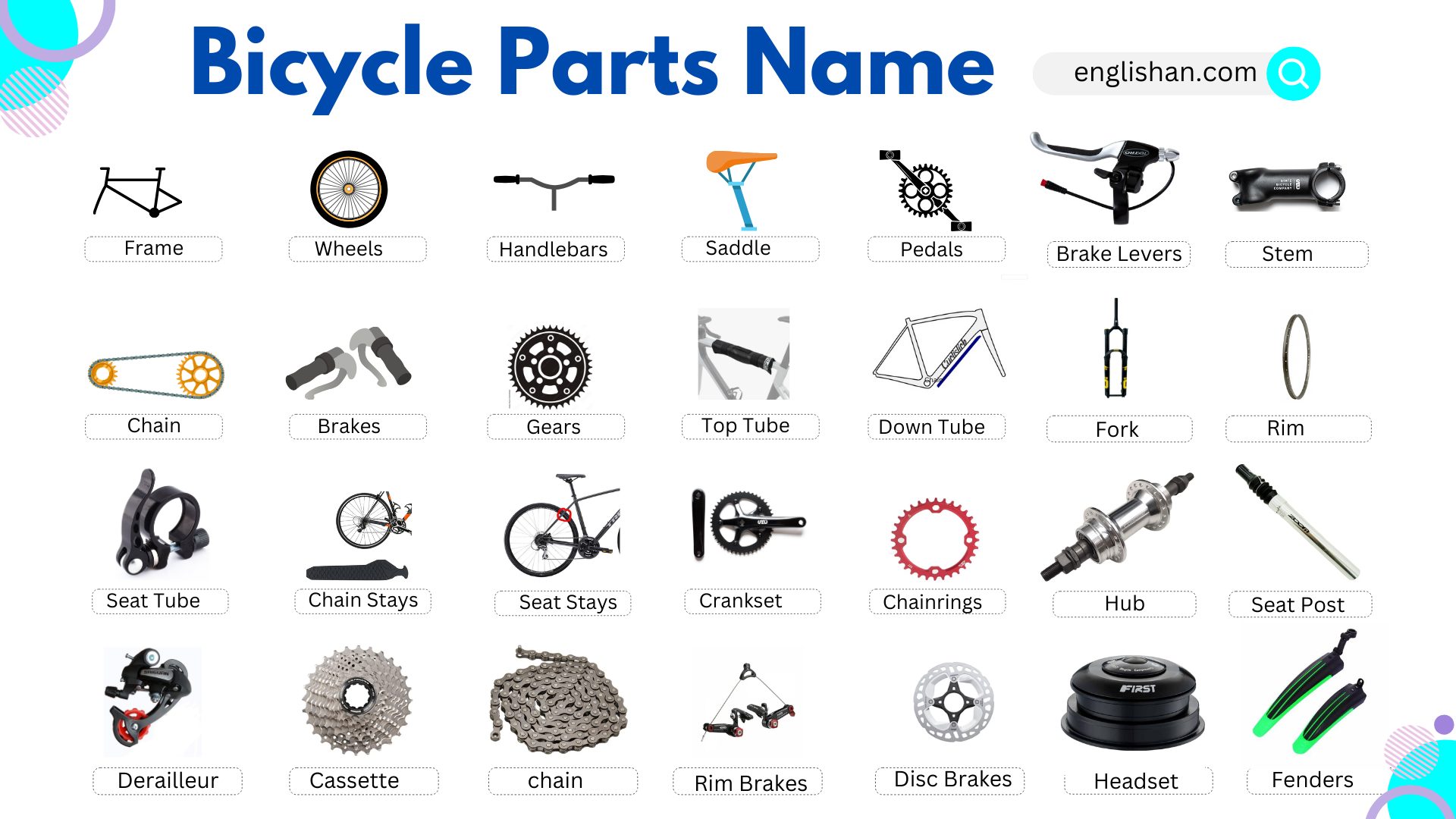Contents
In this blog post, you will learn the names of 100 animals and their homes. Understanding where animals live is essential for improving your vocabulary and knowledge of the natural world. This topic will help you master commonly used words related to animals and their habitats in English.
Want to learn more vocabulary? Visit our Vocabulary Category for helpful resources.
List of Animals and Their Homes
Animals that Live in Dens, Burrows, or Holes

Lion – Den
Lions use dens in rocky areas or dense bushes, often located in savannas or grasslands. These natural shelters protect their cubs.

Wolf – Lair
Wolves create lairs in forests or remote areas, typically choosing caves or dug-out spaces. They use natural terrain for protection and warmth.
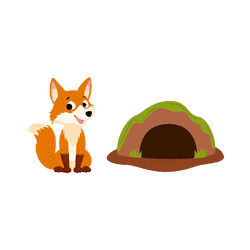
Fox – Hole
Foxes live in holes, also called dens, dug into the ground. These burrows are often found in woodlands, fields, or near human settlements.

Beaver – Lodge
Beavers build lodges from sticks, mud, and logs, situated in freshwater environments. Their homes are usually found in ponds or riverbanks.

Snake – Burrow
Snakes take over burrows dug by other animals, often in dry, warm areas like deserts or forests. They use the earth for warmth and safety.

Mouse – Hole
Mice live in small, hidden holes near food sources, often in fields or inside buildings. They use soft materials like grass for bedding.
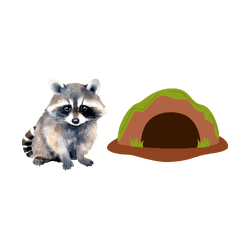
Raccoon – Den
Raccoons inhabit dens in tree hollows, abandoned buildings, or even chimneys. They use available natural or human-made structures for shelter.

Prairie Dog – Burrow
Prairie dogs live in extensive burrow systems in grasslands. They dig deep, complex tunnels for safety, communication, and social interaction.

Skunk – Burrow
Skunks dig burrows or use old ones from other animals, usually found in forests or open fields. They prefer locations near food sources.

Meerkat – Burrow
Meerkats live in large burrow systems in arid regions, such as deserts. They dig their homes in sandy soil to escape predators and the sun.

Ferret – Tunnel
Ferrets occupy tunnels dug by other animals, often in fields or forests. These tunnels provide shelter, warmth, and a safe space for hunting.

Badger – Sett
Badgers create setts, complex tunnel systems often located in forests or grasslands. They dig with strong claws and use soil for stability.

Mole – Tunnel
Moles dig intricate tunnel networks underground, usually in fields or gardens. These tunnels allow them to find food and avoid predators.
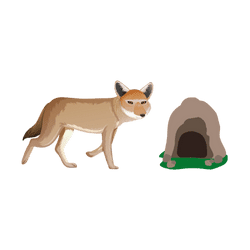
Coyote – Den
Coyotes dig dens in secluded areas like forests or hills. They often choose locations near water sources, using the earth to hide from threats.
Animals that Live in Trees, Forests, or Jungles
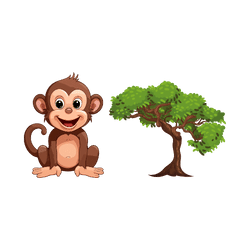
Monkey – Trees
Monkeys live in trees in forests or jungles, using branches for shelter, mobility, and protection from predators in their natural habitat.

Gorilla – Jungle
Gorillas inhabit dense jungles, building nests on the ground or in low trees from leaves and branches, creating a safe resting place.

Elephant – Jungle
Elephants roam jungles and forests, using the landscape for food, water, and shade. They don’t build homes but travel and shelter in natural environments.

Chimpanzee – Forest
Chimpanzees make nests from leaves and branches in forests, often in trees or on the ground, creating comfortable spots for resting and sleeping.

Lemur – Trees
Lemurs live high in the trees of Madagascar’s forests, using branches for shelter and mobility. They rarely come down to the ground.

Panda – Forest
Pandas inhabit bamboo forests, using dense vegetation for food and shelter. They create nests from bamboo to rest or care for their young.

Koala – Tree tops
Koalas live in the treetops of eucalyptus forests, using the high branches as resting spots and for feeding on leaves, rarely leaving the trees.

Python – Jungle
Pythons live in jungles and forests, often finding shelter in trees or burrows. They use the thick foliage for camouflage while hunting.

Jaguar – Rainforest
Jaguars roam rainforests, using dense vegetation and trees for cover. They don’t build homes but use natural terrain for hunting and resting.

Parrot – Rainforest
Parrots nest in the hollows of trees within rainforests. They use the surrounding vegetation and branches for shelter and raising their young.

Sloth – Tree branches
Sloths live in the branches of rainforest trees, hanging from high limbs for protection and movement. They rarely leave the treetops.

Cicada – Tree bark
Cicadas live on tree bark in forests or woodlands, using the surface to hide and breed, as well as to emerge during their life cycle.

Squirrel – Dray
Cicadas live on tree bark in forests or woodlands, using the surface to Squirrels build drays from twigs and leaves, usually high in trees. These nests provide shelter from predators and harsh weather conditions.
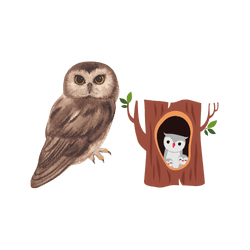
Owl – Tree hollow
Owls nest in tree hollows in forests or woodlands. They use the natural cavities to safely raise their young and protect them from predators.
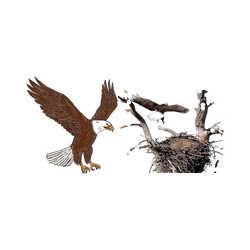
Eagle – Aerie
Eagles build large aeries, or nests, high on cliffs or tall trees using sticks and branches. These elevated homes offer safety and a broad view.
Animals that Live in Water or Near Water

Fish – Pond or Aquarium
Fish live in ponds, lakes, or aquariums, using water plants, rocks, and hiding spots for protection and a stable environment to thrive.

Whale – Ocean
Whales roam the vast ocean, inhabiting deep waters for feeding and migration. They rely on the ocean’s natural landscape for shelter and food.

Otter – Holt
Otters live in holts, dens near riverbanks made from rocks, roots, or hollow logs. They prefer sheltered areas close to water for hunting.

Duck – Pond
Ducks nest near ponds, using reeds and grasses to build nests. They rely on the water for food, shelter, and raising their young.

Penguin – Antarctic
Penguins inhabit the icy lands of Antarctica, building nests from pebbles. They rely on the harsh environment for breeding and protection from predators.

Hippopotamus – River
Hippos live in rivers, using the water to stay cool and for protection from predators. They rest in mudbanks during the day.

Crocodile – Riverbank
Crocodiles live on riverbanks, building nests from mud and vegetation. They rely on the water for hunting and the land for basking in the sun.

Shark – Sea
Sharks inhabit the open sea, using coral reefs or deep waters for hunting and shelter. They roam vast ocean spaces without fixed homes.

Seahorse – Seagrass beds
Seahorses live in seagrass beds or coral reefs, using the plant life for camouflage and shelter. They often cling to plants with their tails.

Dolphin – Ocean
Dolphins live in the open ocean, navigating through coastal waters and deeper seas. They rely on the natural underwater terrain for shelter.

Swan – Lake
Swans live on lakes, building large nests from reeds and grass along the shorelines. They use the water for feeding and raising their cygnets.

Flamingo – Lagoon
Flamingos inhabit shallow lagoons, building mud nests in the water. They rely on the wetlands for food, nesting, and communal living.

Octopus – Underwater cave
Octopuses shelter in underwater caves or crevices, using rocks and sand for protection. They retreat to these dens to rest and hide from predators.

Seal – Shore
Seals live along shorelines, using beaches or rocky shores as resting spots. They spend time in the water for feeding and return to land for breeding.

Lobster – Ocean floor
Lobsters inhabit the ocean floor, using rocks and crevices as shelter. They rely on these natural formations to hide from predators and catch prey.

Manatee – Shallow waters
Manatees live in shallow coastal waters, relying on seagrass beds for food. They prefer warm waters and use the environment for protection and feeding.

Walrus – Ice floe
Walruses rest on ice floes in cold Arctic waters. They rely on floating ice as platforms for breeding, socializing, and escaping predators.

Clam – Sand
Clams bury themselves in the sand along coastal waters. They use the sand as protection while filtering water for food.

Starfish – Reef
Starfish live on coral reefs, using the rocky surfaces for movement and protection. They rely on the reef for food and shelter from predators.
Animals that Live in Deserts, Savannahs, and Grasslands

Giraffe – Savannah
Giraffes roam the savannah, relying on tall trees for food and shade. They don’t build shelters but use natural cover for rest and safety.

Zebra – Grasslands
Zebras live in grasslands, using the open space to graze and stay alert for predators. They find shelter in the landscape’s natural features.
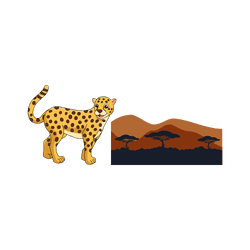
Cheetah – Savannah
Cheetahs inhabit the savannah, using tall grass for camouflage. They rest under trees or in shaded areas, blending into the environment for protection.

Rhinoceros – Savannah
Rhinoceroses live in the savannah, often near waterholes. They use mud for cooling and protection from insects, relying on natural surroundings for shelter.

Ostrich – Savannah
Ostriches thrive in the savannah, relying on open plains for running and foraging. They build nests from shallow scrapes in the ground, lined with vegetation.

Hyena – Grasslands
Hyenas live in grasslands, creating dens from caves or old burrows. They prefer areas with nearby water sources and natural cover for hunting and protection.

Camel – Desert
Camels live in deserts, relying on sand dunes and rocky areas for shelter from the sun and wind. They travel between oases for food and water.

Buffalo – Plains
Buffalo roam the plains, staying in open grasslands where they graze and use natural terrain for protection from predators. They don’t construct homes.

Kangaroo – Outback
Kangaroos inhabit the Australian Outback, using trees and bushes for shade. They rely on the rugged terrain for shelter and access to water.

Goat – Mountains
Goats live in mountainous regions, climbing steep cliffs for safety. They use rocky outcrops and ledges for shelter, relying on the terrain for protection.
Animals that Live in Specific Human-Made Structures

Chicken – Coop
Chickens live in coops, often built from wood and wire, located on farms or backyards. The structure provides shelter, safety, and nesting areas.

Horse – Stable
Horses stay in stables, usually wooden or brick buildings. Located on farms, stables offer protection from weather and provide a comfortable space for resting.

Pig – Sty
Pigs are kept in sties, fenced areas often made from wood or concrete. These enclosures are typically located on farms, offering shelter and space to move.

Cow – Barn
Cows live in barns made of wood or metal, typically on farms. These large structures provide shelter, milking space, and protection from the elements.

Dog – Kennel
Dogs stay in kennels, small structures made from wood or metal. Located outdoors or indoors, kennels provide a safe and comfortable resting area.

Cat – Bed
Cats prefer beds, soft cushioned areas made from fabric or foam. Found indoors, cat beds offer a warm and comfortable space for resting and sleeping.

Donkey – Barn
Donkeys live in barns, similar to cows, made from wood or metal. Located on farms, barns provide them with protection from the elements and predators.

Guinea pig – Cage
Guinea pigs live in cages, typically made of wire and plastic. These indoor structures offer secure living areas with bedding, food, and water.

Hamster – Cage
Hamsters are kept in cages, usually made of plastic or wire. These cages, often placed indoors, provide space for exercise, bedding, and food.

Parakeet – Cage
Parakeets live in cages, typically wire enclosures placed indoors. These cages provide a secure space with perches, food, and water for the bird.
Animals that Live in Nests
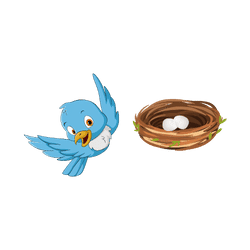
Bird – Nest
Birds build nests from twigs, leaves, and grass, typically found in trees, bushes, or sheltered areas. These nests provide a safe space for eggs and chicks.

Wasp – Nest
Wasps create nests from chewed wood and saliva, forming paper-like structures. These nests are often found in trees, eaves, or other sheltered locations.

Hawk – Nest
Hawks build large nests, called eyries, using sticks and twigs. They are often found high in trees or on cliff edges, offering safety from predators.

Bee – Hive
Bees live in hives made from wax they produce. Found in tree hollows or man-made boxes, hives offer secure places for colonies to thrive.

Spider – Web
Spiders spin webs using silk they produce, creating intricate structures. Webs are often built in trees, bushes, or corners of buildings to catch prey.

Eagle – Aerie
Eagles build aeries, large nests made from sticks and branches. Located high on cliffs or tall trees, aeries provide safety and a broad view of the surroundings.
FAQs:
The name of an animal’s home is called a habitat. Specific names for animal homes include:
1. Nest (for birds)
2. Den (for bears or foxes)
3. Burrow (for rabbits or moles)
4. Hive (for bees)
5. Lair (for wild cats or lions)
6. Tank (for fish)
Here are some animals that have their own “house” or home:
1. Bees – live in a hive.
2. Birds – live in a nest.
3. Rabbits – live in a burrow.
4. Bears – live in a den.
5. Turtles – carry their shell.
6. Crabs – use a shell (hermit crabs).
7. Snails – live in a shell.
8. Ants – live in an ant hill.
9. Termites – live in a mound.
10. Beavers – build a dam or lodge.
An animal’s natural home is called its habitat. This is the place where an animal lives and finds everything it needs to survive, such as food, water, and shelter.
Animals kept at home are called pets. Examples of pets include:
1. Dogs
2. Cats
3. Fish
4. Birds (like parrots or canaries)
5. Hamsters
6. Guinea pigs
7. Rabbits
8. Reptiles (like turtles or snakes)
The home of a lion is called a den or lair. Lions usually rest in caves, tall grass, or thick bushes.
Animals and Their Homes PDF
Get Printable Animals Homes Worksheets
You May Also Like



